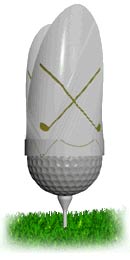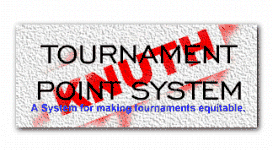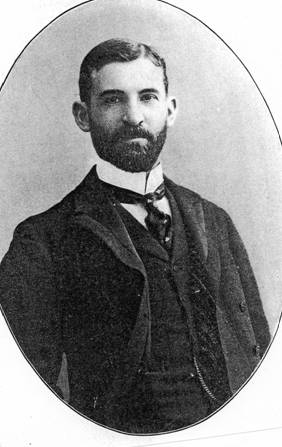|




|
HANDICAPPING
By Walter J. Travis
July,
1901

Dean Knuth’s notes on Walter J. Travis and this article: Walter J. Travis (1862 – 1927, playing out of Garden City CC, Long Island, New York) was the most successful amateur golfer in the U.S. during the early 1900s. He was a noted golf journalist and publisher, an innovator in all aspects of golf, a teacher, and a respected golf course architect. Travis was the country's top amateur golfer, winning the U.S. Amateur Championship in 1900, 1901 and 1903. In 1904, he became the first non-British golfer to win the British Amateur Championship-- a feat that would not be duplicated for another 22 years even with repeated attempts by Jerome Travers, Francis Ouimet, and Bobby Jones. This article is from Travis’ excellent book: “Practical Golf”. The first USGA Handicap System wasn’t adopted until ten years later (1911) and the Metropolitan (New York) Golf Association was the leading association in the USA in handicapping for its member clubs at this time. Mr. Travis discusses several key issues in handicapping: 1. Being able to compare golfer’s handicaps from one club to another. 2. The need for a standardized “par” (Course Rating), 3. The need for club handicap committees to evaluate scoring performance, 4. The need for at least two handicap revisions per season, and 5. The difficulty of making handicaps based on stroke-play scores work also for match play competitions. He was a very forward thinker who was far ahead of his time. Although the USGA Course Rating and Slope Rating System has made handicaps portable, the issue of USGA Handicaps working uniformly well for all forms of competitions is still an issue. The following is an exact duplication of pages 172 through 177 of his book. This article first appeared in “Golf” magazine in July,
1901. Travis later founded and published The American Golfer magazine. He was its Editor until he turned it over to Grantland Rice in the Spring of 1920.
HANDICAPPING
THE essence of handicapping is to put all the players on a common level—to give the poorest player an equal chance to win with the rest of the field. In order to adjust the handicap fairly it is necessary to work upon some definite principle. As a general thing this is comparatively easy, especially if a| record is kept of the scores of the players. To assist the handicap committee in establishing the status of each member, at least three consecutive scores, duly attested, should be handed in by every player, and a detailed record should be kept for future reference. Scores made in competition should also be recorded. Any failure to hand in competitive score should be visited by a penalty of a stroke in the delinquent’s handicap. With some such system it would not take long to arrive at a fairly definite idea of the capabilities of each and every player. As a further aid it is not a bad plan to get each player to fix the handicaps of all the other players, particularly in newly formed clubs, until something is known by the handicappers of the members' respective abilities.
The handicap committee should consist of not more than three, who should be in frequent touch with the active players. After every competition, revisions, if necessary, should be made in the official ratings, which should be kept posted, in alphabetical order, in the clubhouse.
In establishing the handicaps it is customary to work up from the best player in the club, who is rated at scratch. By far the better plan, however, is to take as a basis the par—not the bogey—of the course, which is a fixed quantity. Par golf, it may be remarked, is perfect golf, determined according to the distances of the holes and with two strokes allowed on each green, while bogey simply represents the score of a good player who occasionally makes a mistake, not very glaring, but sufficient to make a difference in the round of four or five strokes. Bogey is an elastic quantity, however, so much so, indeed, on some courses, as to furnish no true criterion of the game of the player who now and then beats the Colonel (Colonel Bogey).
If all clubs adopted the practice of handicapping from par it would be an easy matter to fix the standing of every player throughout the country. As it is, however, a scratch player at Stumpville may conceivably be entitled to a handicap of nine strokes from a scratch man at Bunkerville. This, of course, has to be taken into account by the handicap committee in an open handicap tournament, and adds materially to the difficulty of placing all the competitors on an equitable footing. So far as New York and its immediate vicinity is concerned the Metropolitan Golf Association has accomplished a very good work by classifying all the players of the various clubs in the association up to a limit of seventeen strokes. The handicaps are fixed at the beginning of the season, and, necessarily, are based upon the performances of the preceding season. So far as it goes this official ranking of the players has proved of much assistance, but it would| perhaps be of greater value if the list were revised at least once during the season—after the local championship meeting, for instance.*
- EDITOR'S NOTE.—Since the foregoing was written; it has been decided by the Metropolitan Golf Association to readjust the handicaps twice each season—at the beginning of the season, and again in August.
The Metropolitan Golf Association ratings, in common with the large majority of individual clubs' handicap lists throughout the country, rest upon score play only. Each club, however, should compile a separate table of strokes for match play instead of, as is usual, allowing three-fourths of the difference in handicap allowances, counting a half-stroke, or over, as one. As a general thing such difference is applicable to most players, but, obviously, not all. For example, A, the scratch player of a club, may average eighty, while B's average score is ninety, generally due to a few poorly played holes. To average eighty on a good course presupposes fairly consistent play. Now in match play A would have to concede B eight strokes on the latter's handicap of ten strokes in score competition. Let us take the hypothetical average cards of each and see what the result would be:
A's score, out: 4 3 4 5 4 4 5 5 5—39
B's score, out: 4 3 6 5 4 3 7 5 7—44
A's score, in: 5 5 4 5 4 5 5 5 3—41
B's score, in 6 5 4 7 4 5 6 5 4—46
Playing level, A would beat B four up and three to play. Conceding eight strokes, however, one each at the second and each alternate hole up to the sixteenth, it will be seen that B would beat A three up and two to play.
This is an example of simply an ordinary case. There are, of course, a few more pronounced, where the difference would be much greater, both in favor of and against the scratch man. It is quite possible for a player to be good at medal play and poor at match play, and vice versa. A poor scorecard may show remarkable strength at hole play, stronger, indeed, than one aggregating half a dozen strokes less for the round.
In order to gauge the game of a player as a match player—which, after all, is the supreme test of golfing ability—it should be incumbent on the handicappers to carefully analyze the score for each hole, such analysis embracing at least three or four typical or representative cards, before any fair allowance can be made applicable to hole play, considered alone. Nor is this the only essential. Regard must also be had for the known strength or weakness of the player at both score play and match play, as the case may be. Few men are relatively good at both. No hard and fast rule can be laid down, as temperaments vary, and sometimes in opposite directions.
Sufficient has been said to indicate the necessity of fixing separate handicaps for score play and match play, certainly in some cases, instead of simply accepting the aggregate medal score as the basis and universally allowing the regulation three-fourths of the difference.
The match play allowance in foursomes is three-eighths of difference between the aggregate handicap allowance on either side, a half-stroke, or over, counting as one, smaller fractions not being considered.
In match play strokes received are usually taken as shown in table below:

Most clubs, however, may find it advisable to arrange a schedule of their own, according to the special nature and difficulty of the various holes. Such list should be posted in the club-house.
Another form of handicapping which is productive of very interesting matches is to allow your opponent so many " holes up" at the start. The usual mathematical proportion is two-thirds of the medal handicap. For instance, if the handicap allowance is nine Strokes, six holes are conceded by a scratch player. This principle must, however, be modified somewhat as the higher handicaps are reached. Such system is not applicable to a club where members receive such handicaps as twenty to thirty strokes, as on the latter basis the scratch player would start twenty holes down in eighteen, which, of course, is ridiculous.
Another method, less commonly observed, is the giving of so many bisques, each representing a stroke to be taken at the pleasure of the player receiving them, after the hole has been played. The use of a bisque at a halved hole converts a half into a win in favor of the receiver, or into a half if only one more stroke has been taken.
Still another plan is to concede all holes as lost when halved, only those won outright counting in favor of the giver of such odds.
Generally speaking, the three last mentioned methods of adjustment are better adapted for private matches than for regular competitions, as it is much easier for two players to arrange their own terms between themselves so as to place them on a very close level, than it would be for the handicap committee to arrive at anything like satisfactory results with a large field. Everything considered, the system first referred to is capable of broader application, and fairer, generally, when the competition embraces a number of players. The mutability of the game of the average player makes it impossible to reduce any system of handicapping to an exact science—and it is perhaps just as well that it is so.
|






